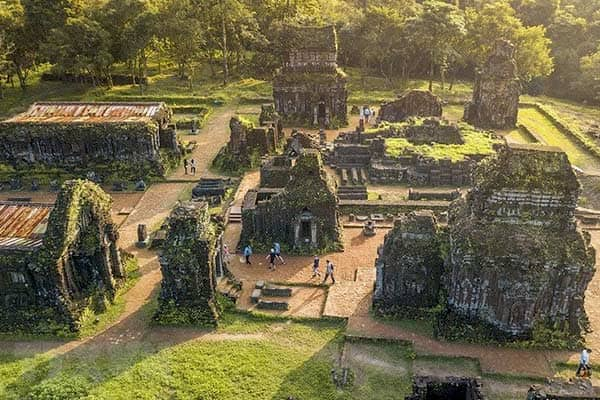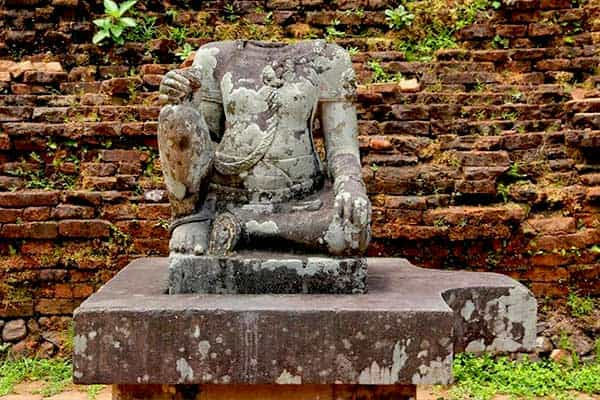MY SON – CENTRAL VIETNAM
HISTORICAL, CULTURAL AND ARTISTIC VESTIGE OF THE KINGDOM CHAMPA
My Son includes a group of towers and temples as well as the ruins of an imperial city in the kingdom of Champa, located in central Vietnam. It is an example of the evolution and change of culture and one of the main proofs of an Asian civilization that has now disappeared. My Son can be considered as the equivalent of places like Angkor Wat in Cambodia and the Valley of the Kings in Egypt. With its high value, in 1999, the My Son complex was recognized as a World Heritage Site by UNESCO.
History of My Son
The My Son temple complex was built between the 4th and 14th centuries. It was the centre of worship of the Champa people who owned five kingdoms in the surrounding regions. After the defeat of the Champa kingdoms for centuries, these temples were abandoned in the midst of the lush nature of Hon Quap Mountain and the Thu Bon River.
The explorer Camille Paris rediscovered the sleeping temples during his mapping expedition to Vietnam in 1889. Later, in 1903, Henri Parmentier, a French archaeologist and his team began excavations on the site, which lasted eleven months. They documented 71 rediscovered structures within a two-kilometre radius. They also managed to restore some of them, but unfortunately, the secret holy place was bombed during the Vietnam War in 1969, when American forces attacked the Viet Cong who had settled in ancient ruins in central Vietnam.
They embarked on a restoration project, realizing the importance of the site, comparing it to sites such as Angkor in Cambodia, Borobudur in Indonesia and Ayutthaya in Thailand. But in August 1969, much of this restoration work was cancelled.
In one week, the section of My Son that houses the largest temples - the most impressive and sacred - was transformed into a pile of rubble. Fortunately for the cultural heritage of humanity, some sections have survived and can still be visited today.

The towers of My Son
Architecture of My Son
The first temples of My Son were built of wood in the 4th century. After it was destroyed by fire, the kings of the Champa kingdom decided to build the structures with red bricks.
The main temple worships the Linga-Yoni, which represents the capacity for invention. Next to the main tower (Kalan), several sub-towers worship geniuses or dead kings. Although time and wars have destroyed some towers, the remaining sculptural and architectural remains still reflect the style and art history of the Cham people. Their masterpieces mark a glorious period for the architecture and culture of the Cham, as well as Southeast Asia.
During the excavation, Henri Parmentier organized the My Son complex into 14 sections according to the alphabet. For better orientation, each temple has its own number in a group, for example A1, A2, B1, B2, etc.
All the Cham towers were built on quadrat foundations and each one has three parts: a solid base, representing the world of human beings, the mysterious and sacred body of the tower, representing the spirit world, and the top of the tower in the shape of a man offering flowers, fruits, trees, birds, animals, etc., representing things close to the spirit and man. The interior is simple and quite dark, because the places of worship had no windows. Darkness created the right conditions and helped the shamans who entered the temples to communicate with the deities.
If you look more closely at the walls, you will not see any mortar or other visible elements that would hold the bricks together. You will also notice that some bricks are covered with foam and some are red. Guess which ones are the originals and which ones are new? The Cham knew very well the technique of brick firing and the proof of their brilliant skills is there, on the walls of several thousand years! Thus, while the new bricks of the renovations have started to change colour, the original ones keep their red colour!
The bombardment left only 17 structures out of 71, although Vietnamese and international teams have been carrying out conservation work on the site since 1975. Unfortunately, floods caused by the river and climatic conditions such as high humidity compromise the site's ability to preserve.
My Son Shrine is considered one of the best examples of Hindu architecture in Southeast Asia, and no photo or video will give you the same impression as a walk among the temples. This is therefore a very rewarding stopover during your trip to Central Vietnam.

Sculpture at My Son
Visit of My Son
My Son has three zones. The first is a relatively complete temple complex with a dozen buildings. These are formed at different stages of Shiva's worship ceremonies and are aligned with the movements of the sun.
The second area is where the bombs destroyed a complex of temples. Grass has grown a lot and it is difficult to get an idea of what has been grown for centuries.
The last area is composed of two adjacent areas where restoration has taken place or is underway. The difference in colour, texture and age of the bricks of these temples is obvious.
Near the ticket office is a museum, describing many artifacts and the history of the site. Therefore, try to visit the museum briefly before visiting the temples themselves - it closes half an hour before everything else, so you may not be able to spend it on your way out.
The temples are in variable states, with restorations still in progress on some. They are located in nine "groups", called A-G. In fact, there are six main sites: A, B-C-D and E-F. Ruins G, H and L are separated and a little more difficult to find. If you can't find them, don't spend the day trying; they're much smaller than the others. All sites are linked by reasonably well-labelled hiking trails.
There are traditional Cham dance shows at different times of the day, mainly in the morning. The scene is just before arriving at the first group of ruins, in front of the souvenir shop.
Some tips during your stay at My Son
- Entry ticket: 150 000 VND
Opening hours: 6am - 5pm
- Ideal time to visit My Son: Visit My Son early in the morning, just after the door opens, but there are more and more tourists coming from Hoi An for guided tours at sunrise. This is worth it and will remain one of the key moments of your trip to Central Vietnam.
- Be sure to enter the museum after passing through the ticket office. You will find many wall posters explaining the history of My Son, which will help you especially if you are considering exploring the site without a professional guide. (There are no English plates around the temples.)
- Use the free electric shuttle that will pick you up at the station behind a bridge when you leave the museum. The journey takes about 10 minutes and will take you to a lush jungle while saving you a ton of energy if you visit My Son in hot weather. The shuttle leaves every 15 or 25 minutes, depending on the time of day.
- You can also find food stands selling gifts, ice cream and drinks near the entrance to the ruins.
- Walk only on marked paths and do not go alone to the lush forest, as a demining process is still underway in the My Son area.
- Don't forget the water and sunscreen as it is very hot.



